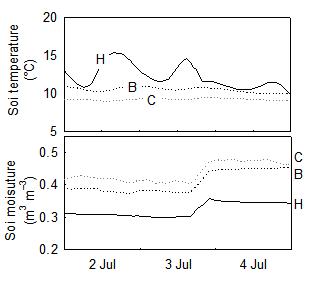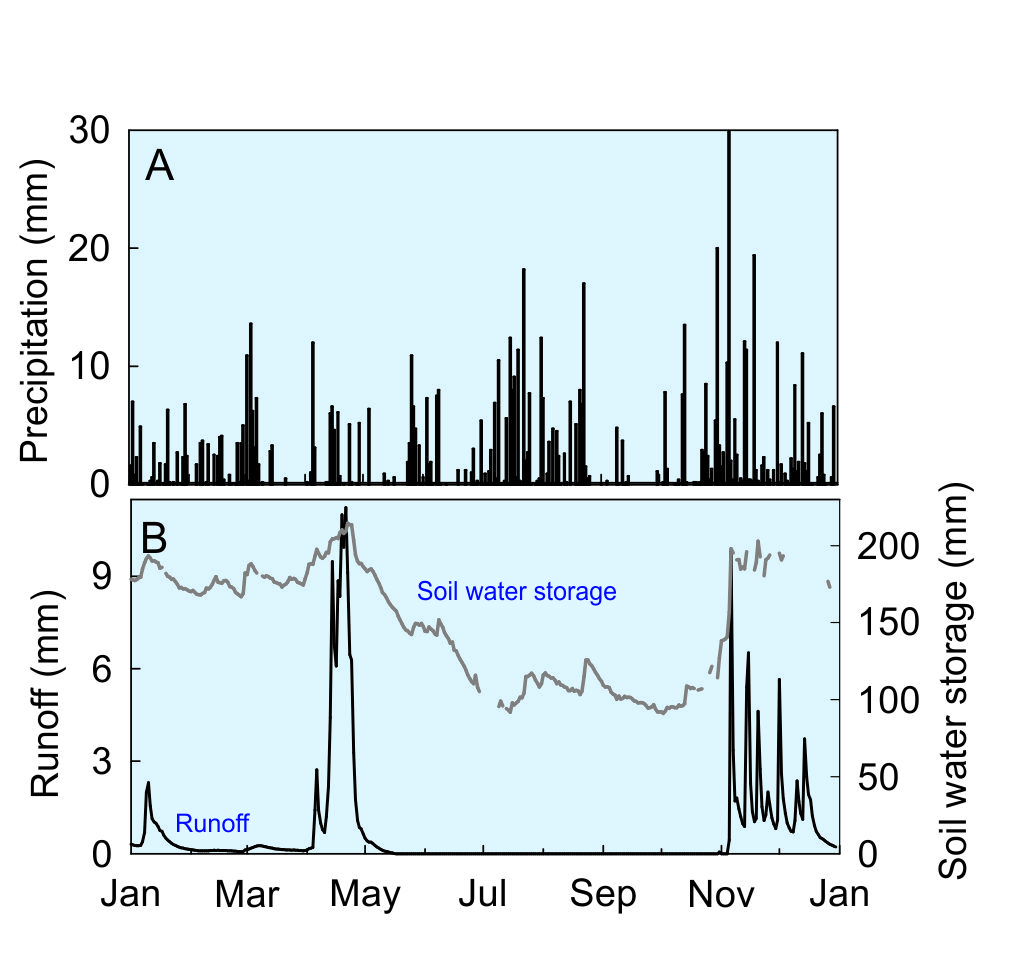Water plays an important role in the biological and chemical processes occurring in the soil. Together with soil temperature, they affect carbon and nitrogen cycles in forests.
The soil of our site is moraine, like most of the soils in Finland. This kind of soil is fully saturated with water, if water content reaches 50% of the volume. This can happen for example in spring during snow meltdown. In summer during severe drought, the soil humidity may decrease down to 10%, but in normal conditions the soil humidity varies between 20% and 30%. After heavy rain it can occasionally reach 35%.
Water is bound in the soil by several physical and chemical mechanisms. A water molecule has an electrical dipole characteristic that has its origin based on surface tension and capillary force. These molecular interactions together with the soil pore structure result in soil water tension that is expressed in pressure units. The soil water tension is a better indicator than soil water content for measuring soil moisture conditions that a plant undergoes.
Soil moisture increases with rain and decreases during rainless period. Therefore, soil moisture does not have a clear diurnal pattern unlike soil temperature. Soil moisture does not have a clear annual cycle either, but during most years, the soil moisture is high in spring and autumn whereas it decreases during the warmest summer months.
Currently, there are many methods for determining soil water content on the basis of volume (m3m-3) or tension (kPa). In continuous field soil water measurements, two methods are dominating: time domain reflectometry (TDR) measuring water content and tensiometers measuring water tension. In the Observations section, you can view and download soil water measurements made at Hyytiälä Forestry Field Station.
The time domain reflectometry (TDR) technique uses stainless steel rods inserted into the soil. They generate an electromagnetic pulse and observe the energy reflected by the soil. The soil moisture can be determined by analyzing the magnitude, duration and shape of the reflected waveform with empirical instruments. If the soil is saturated, the travel time of the wave is long whereas in dry soil, the travel time is short.
Tensiometers measure the soil moisture content as tension or pressure acting in a similar fashion to a plant root. It measures the force that plants have to exert to obtain moisture from the soil. In practise, it is a plastic tube with a ceramic cup at the lowest end. The tube is filled with water and pressed into the soil. As the soil dries, the water is lost from the tensiometer via the ceramic cup. The loss of water creates a vacuum in the tensiometer and is reported as a pressure reading. The drier the soil, the higher the pressure reading.
REW stands for “Relative Extractable Water” and it refers to the amount of soil water available to the plant.
Absorption of soil water through the roots is essential to keep up the biological activity in plants. When the amount of water in the soil decreases it gets increasingly difficult for the roots to provide water to the plant and compensate for the simultaneous loss of water from the leaves. In order to decrease this demand, a similar effect as that of high VPD is produced: stomatal pores close and CO2 flow and photosynthesis decrease.
Field capacity (FC) is maximum amount of water that a soil can hold.
Wilting point (WP) is defined as the minimal point of soil moisture the plant requires not to wilt. A plant wilts and can no longer recover its turgidity if moisture decreases to any lower point.
REW is calculated using measured soil moisture (SM, m3 m–3), wilting point and field capacity:
REW = ( SM – WP ) / ( FC – WP ).


